Jun 14, 2022 | Carson City, coins, dollar, errors, grading, GSA, Morgan
Life can be confusing. One of those confusions is when people do something for reasons that are not obvious. Then when the people were asked why they did not offer any answers.

1882-CC GSA “Grand Snake Morgan Dollar Struck 15% Off Center graded NGC MS 65 (Image courtesy of NGC)
The coin is fascinating in that it looks stunning, survived for so long to be part of the GSA Hoard, and the original owner purchased the coin for $30 in 1972. But that is not what makes this coin a curiosity.
Rather than NGC applying the tamper-evident label that NGC wraps around the GSA holder, NGC placed the entire GSA holder in one of their Mega Holders.
According to NGC’s website, the Mega Holder can hold a coin as large as 180 mm (about 7-inches) in diameter and 28 mm (about 1.1-inches) thick. The NGC holder appears to be three times the size of the GSA holder.
Understandably, a collector would send a coin of this significance to NGC for authentication and grading. But why did NGC have to slab the entire GSA holder? The coin is 38.1 mm in diameter (less than 1-inch) and is in a holder for a coin seven times its size. The coin, which should be the central focus, appears lost.
I tried to ask NGC about their decision to slab the entire GSA holder, and the response I received referred me back to the article that does not discuss the decision. There must be a reason other than “this is what the client wanted.” Even if NGC does not want to answer the question, I want to see the coin in person.
Mar 8, 2014 | Carson City, coins, gold, GSA, history, news, rareties, US Mint

One of the cans found as part of the Saddle Ridge Gold Coin Hoard
This is not to say that treasures can only be found in California. As someone who has started a business dealing with collectibles, I have found interesting items at good prices in the most unexpected places. The concept is not to start digging where someone else made their discovery but look for clues to new finds elsewhere. Chances are that the next find will not be the same area.
One of the more interesting aspects of the Saddle Ridge Hoard story is the speculation of where the coins came from and why were they buried in that location. The most entertaining was the story that these coins were stolen in 1901 from the U.S. Mint in San Francisco. Even though it sounds plausible, the details of what would have happened based on historical record does not support this theory.

The old San Francisco Mint building built in 1874
Also, the U.S. Mint is not a bank. It does not save inventory. Records† show that over the years, the U.S. Mint loathes keeping inventory for long periods of time. These sources report a revolving inventory suggesting that only the 1933 Double Eagles may have been kept in the vaults longer than other coins while the policies about gold coins were being settled.
Anticipating the question about the GSA Hoard of silver dollars, those coins were not stored by the U.S. Mint. Those dollars were delivered to the Department of the Treasury to use as backing for silver certificates. The storage areas where the coins were found were either facilities used or leased by Treasury. Coins that were melted under the Pittman Act for sale to the British to help them fund their defense in World War I were coins held by the Treasury. Coins struck to replace the melted coins were then stored in Treasury facilities.
When the General Services Administration (GSA) worked to consolidate and reduce office space in the 1960s, millions of mostly Morgan dollars struck in Carson City were found in several buildings including in storage areas off the historic cash room in the Treasury Building in Washington, D.C. Coins were sold the public by sealed bid over five auction sales between 1972 and 1974 with one final sale in 1980.
Up until 1964, anyone could trade a silver certificate for silver coin at par (e.g., $1 silver certificate for one silver dollar). This ended when silver rose in price making the price of silver more expensive than par value.

One of the 1,427 “Saddle Ridge Hoard” buried treasure gold coins certified by PCGS
Saying that the Saddle Ridge coins were once stolen from the Mint makes for a good headline. Good headlines makes for page views and page views translates into more advertising dollars for those blindly reproducing the erroneous story without checking the facts. Unfortunately, the truth cannot be explained on a bumper sticker or in a sensational headline—but that does not mean I will not try!
See the Saddle Ridge Hoard at Whitman Baltimore
It is being reported that Don Kagin will bring many of the coins in the Saddle Ridge Hoard to the Whitman Expo that will be held March 27-30, 2014 at the Baltimore Convention Center. If you need an excuse to come to Baltimore aside from attending the largest coin and currency show that is not run by the American Numismatic Association, coming to see the Saddle Ridge Hoard before it is broken up and sold later this year.
† A good reference for U.S. Mint statistics is a government-produced publication named Domestic and Foreign Coins Manufactured by the Mints of the United States: 1792-1965. It has been scanned several times and can be found on one of the many archive sites. The problem is that I found only one good scan, and it is not the best, but forgot where I downloaded it from. Printed copies are even more difficult to find.
Credits
- Image of the can of gold coins from the Saddle Ridge Hoard courtesy of Kagin’s.
- Image of the old San Francisco Mint courtesy of Wikipedia.
- Image of the graded eagle courtesy of Professional Coin Grading Service.
Oct 27, 2012 | auction, Carson City, coins, gold, GSA, silver, tokens
How many of you look at the online auctions from the auction houses dedicated to numismatics and feel intimidated?
I can see quite a few virtual hands raised. You probably like coins shows but find the large crowds at some of those shows may also be intimidating. After all, you’re a collector, not an investor or a professional. Sometimes, you can find gems at smaller shows and even smaller auctions.
This is why I was intrigued by an auction notice sent by Stephenson’s Auctioneers and Appraisers from Southampton (Bucks County), Pennsylvania. Judging by their website, Stephenson’s is a local auction company that mainly serves buyers and sellers in its region with and probably has some clientele outside the eastern Pennsylvania area where they are located.
The nice thing about these local auction houses is that they are more accessible than the big houses and they usually have items that are affordable to the average collector. While high-end auctions are fun, if you are buying for yourself, you may not be the type looking to spend six-figures or higher on a coin.
If that is the case and you are in the Bucks County, Pennsylvania area on Friday, November 2, you may want to stop by Stephenson’s and check out their more than 200-lot coin auction that may include “some nice last-minute surprises.”
These are estate auction from the eastern Pennsylvania area. According to the information sent to me, the auction includes a wealth of Morgan silver dollars will be offered, with no fewer than 15 lots comprised of three Morgans each. An uncirculated 1882 Carson City Morgan silver dollar is one of the highlights, and another early example is a trade silver dollar dated 1877. Other antique American coins include Capped Bust half dollars from 1809 and 1838; an 1806 Draped Bust half dollar, and a Seated Liberty half dollar from 1843.
The auction includes two gold pieces. One is a 1914 Indian Head quarter eagle ($2½) and a 1917 $1 gold coin commemorating the slain U.S. President William McKinley.
There are many collectors’ books of coins, including a Washington quarter book (1932-1945) with 24 silver quarters, a Liberty Head nickel book (1883-1912) with 25 nickels, a Standing Liberty book with 10 silver half dollars, a Mercury dime book with 74 silver dimes, including 1921 and 1921-D; and a book consisting of 60 Buffalo nickels. Also included are a Walking Liberty half dollar book with 14 half dollars, a Barber dime book, Roosevelt dime book and Kennedy half dollar book with 59 Kennedy halves, including three 1964 and nine 1965 through 1970 coins. Flying Eagle and Indian Head penny sets will be available, as well as many other books, too numerous to mention.
Desirable non-monetary gold and silver items with both intrinsic and historical value include a boxed set of three 24K gold over .999 silver ingots commemorating the 1973 Triple Crown Winner Secretariat, and a framed sterling silver set titled “The Official Bicentennial Medals of the Thirteen Original States.”
Other lots of interest include two California Gold tokens (1852 and 1853) and an 1860 $5 note issued by the Miners and Planters Bank of North Carolina. Fractional currency, and U.S. Prestige and Olympic Prestige sets.
Auction will be held on Friday, November 2, 2012 at Stephenson’s gallery located at 1005 Industrial Blvd., Southampton, PA 18966. Auction preview is on the auction day from 2-4 p.m. The auction starts at 4 p.m.
For additional information, call Cindy Stephenson at 215-322-6182 or e-mail info@stephensonsauction.com. There will be no Internet bidding for this sale; it is exclusively for gallery, phone and absentee bidders. Visit Stephenson’s online at www.stephensonsauction.com.
If you are in the area, go and have some fun. Who knows, you may find something interesting to bid on!
Some of the items in this auction
-

-
1882 Carson City uncirculated Morgan silver dollar with original GSA box and paperwork. You do not see too many CC Morgans with the original box and paperwork!
-
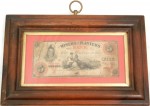
-
1860 $5 note, Miners and Planters Bank of North Carolina.
-

-
Three 24K gold over .999 silver ingots Commemorative of Secretariat.
-

-
Thirteen sterling silver “Official Bicentennial Medals of the Thirteen Original States.”
-
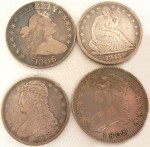
-
Early US coins, including 1809 and 1838 Capped Bust half dollars, 1806 Draped Bust silver dollar, and a, 1843 Seated Liberty half dollar.
-
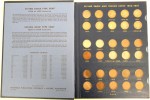
-
Flying Eagle and Indian Head Cent set in a Whitman Album
-

-
1914 Indian Head Quarter Eagle ($2½) gold coin and McKinley Commemorative “Dollar” gold piece.
-
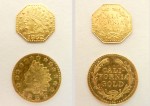
-
1852 and 1853 California Gold Rush tokens
All images courtesy of Stephenson’s Auctioneers.
Mar 24, 2007 | coins, dollar, GSA, shows
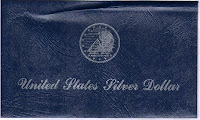 While walking around the ANA National Money Show on Saturday with my father, I met a dealer who had a blue envelope that said “United States Silver Dollar” in a fancy script on the cover with a 1922 Peace Dollar in a shrink wrap next to the envelope. I was intrigued and asked the dealer about the coin. The dealer removed it from his case and told me that he bought as part of a lot with other items. The dealer did not know much about the coin except that it was sold as part of a “GSA Hoard Sale” that was offered after the sale of the well known Carson City Dollars.
While walking around the ANA National Money Show on Saturday with my father, I met a dealer who had a blue envelope that said “United States Silver Dollar” in a fancy script on the cover with a 1922 Peace Dollar in a shrink wrap next to the envelope. I was intrigued and asked the dealer about the coin. The dealer removed it from his case and told me that he bought as part of a lot with other items. The dealer did not know much about the coin except that it was sold as part of a “GSA Hoard Sale” that was offered after the sale of the well known Carson City Dollars.
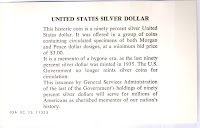
 I like Peace Dollars. Aside from being a classic beauty, the are the first non-modern set I put together—which includes the 1928 Peace Dollar my fiancée (now my wife) bought for me as a gift! Within the envelop was the dollar shrink wrapped with a special GSA token and two information cards. One card was about the coin and the other about the sale. The more I looked, the more interested I became.
I like Peace Dollars. Aside from being a classic beauty, the are the first non-modern set I put together—which includes the 1928 Peace Dollar my fiancée (now my wife) bought for me as a gift! Within the envelop was the dollar shrink wrapped with a special GSA token and two information cards. One card was about the coin and the other about the sale. The more I looked, the more interested I became.
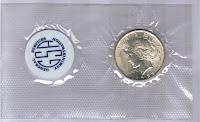 With loupe in hand, I looked closely at the coin. Even though the cards say that the coin is circulated, the dealer and I agreed that if it was circulated, that it was very lightly handled. Some wearing on Liberty’s cheek and neck along with the nice luster had both of us agreeing that the coin should grade MS62/63. The dealer was asking for a modest price over the price he paid, so I made the purchase.
With loupe in hand, I looked closely at the coin. Even though the cards say that the coin is circulated, the dealer and I agreed that if it was circulated, that it was very lightly handled. Some wearing on Liberty’s cheek and neck along with the nice luster had both of us agreeing that the coin should grade MS62/63. The dealer was asking for a modest price over the price he paid, so I made the purchase.
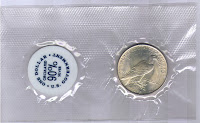 When I came home, I searched for more information and found this site that explained how the GSA sold what has been called the “GSA Hoard” that included the famed Carson City Dollars and over 100,000 additional circulated and uncirculated silver dollars. This report noted that there were “84,165 circulated and 27,980 uncirculated coins minted between 1859 and 1935.” The 84,165 circulated silver dollars were various types including Seated Liberty, Morgan and Peace Silver Dollars with mint marks from other US Mint branches.
When I came home, I searched for more information and found this site that explained how the GSA sold what has been called the “GSA Hoard” that included the famed Carson City Dollars and over 100,000 additional circulated and uncirculated silver dollars. This report noted that there were “84,165 circulated and 27,980 uncirculated coins minted between 1859 and 1935.” The 84,165 circulated silver dollars were various types including Seated Liberty, Morgan and Peace Silver Dollars with mint marks from other US Mint branches.
The article reports that the GSA never published the number that they sold of the blue softpack dollar. It is estimated that there were 100,000 of these coins sold.
The ANA National Money Show in Charlotte was a lot of fun. Now it is time to go to Baltimore for the Whitman Baltimore Coin and Currency Convention.

















